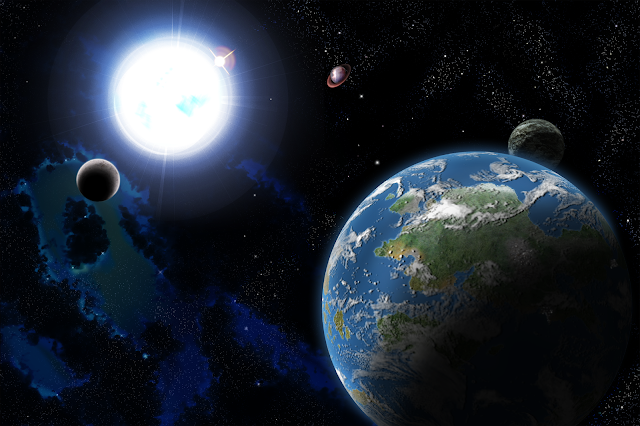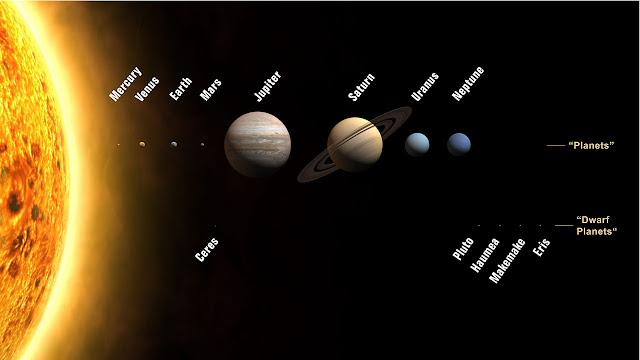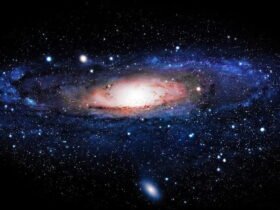 |
| Fig: Planets |
Overview:
Planets is a solid spherical body which revolves around the stars, it can be one star or two or more than two because of gravitational force. Planet can be in any formed hard Rock, Gas(cloud) and Liquid. Planet can have its own environment or atmosphere which has weathering formation according to heat and pressure.
The most commonly known planets are the eight that make up our solar system: Jupiter, Saturn, Uranus, Neptune, Earth, Venus, Mars, and Mercury. However, there are many more planets that exist outside of our solar system. The IAU has classified the Planets on the Basis of compositions they are made from. Some of them which we know are:
1. Terrestrial Planet
2. Silicate Planet
3. Proto planet
4. Ocean Planet
5. Iron Planet
6. Lava Planet
7. Ice Giant Planet
8. Gas Dwarf Planet
9. Helium Planet
10. Carbon Planet
In our Solar System, astronomers often divide the planets into two groups mainly -the inner planets and the outer planets. The inner planets are closer to the Sun and are smaller and rockier. The outer planets are further away, larger and made up mostly of gas and liquid.
The inner planets (from the sun, closest to furthest) are Mercury, Venus, Earth and Mars. After an asteroid belt comes the outer planets, Jupiter, Saturn, Uranus and Neptune.
Our Sun is kind of young star -white, So it will take millions of year to die and became dead -red star and get blow.
Fact: All the Planetary name is given on the Roman-Greek mythology.
Inner Planets
1. Mercury: /ˈməːkjəri/
With similar name it reminds us of element Hg-Mercury in our chemical periodic table with Atomic Number 80. But this Name is given on the God !!! yes a GOD from Roman mythology His name derives from the Latin word ‘merx’ meaning” merchandise”, as Mercury was originally the Roman god of tradesmen and thieves. Mercury was the son of Jupiter and Maia. It is smallest planet in our solar system, which revolves around the Sun in 88 days and rotates in own axis in 59-earth days. It has no natural satellites but has small atmosphere called exosphere oxygen, sodium, hydrogen, helium and potassium. The NASA MESSENGER (MErcury Surface, Space ENvironment, GEochemistry, and Ranging) spacecraft is currently orbiting the planet.
2. Venus : /ˈviː.nəs/
In Roman mythology, Venus was the goddess of love, sex, beauty, and fertility. However, Roman Venus had many abilities beyond the Greek Aphrodite; she was a goddess of victory, fertility, and even prostitution. Even it is not so close to Sun as much Mercury and still it is a hottest Planet in our Solar system. It’s so hot that Lead metal is in liquid form 460˚-470˚C. It has a large amount of greenhouse gas like clouds of Sulphuric Acid, Carbon Dioxide gas and Nitrogen. Because of the gas is trapped inside the atmosphere it gets continuously heats up and keeps warm. Venus is really similar to Earth it has mountains and active Volcanoes and also called active Planet. Its size is 0.8x times the Earth.
Venus is little bit Unusual then others like in spinning nature- it spins in opposite direction than earth and other planets. It takes about 243 day to rotates on its own axis and 225 days to complete one orbit around the Sun because of closeness. So the Day is longer than the Year on Venus. And just like Mercury Venus also doesn’t have any Natural satellites (moon).
Landing is somewhat not possible on Venus due to dense clouds and high temperature.
3. Earth : Synonym of earth in different mythology are-
Gaia
Rhea
Danu
Cybele
Terra
Nerthus
Asase Ya
Ninhursag
Pele
Pachamama
Cōātlīcue
Mokosh
Ops
Prithvi
Nantosuelta
Kishar
Tlazōlteōtl
Triple Goddess and there are many more :-
Earth is the only planet in our solar system where water was found and later it is found in Titan(Saturn moon).But it is only life supporting planet still in our solar system. Yes there are many other different planets which were find from Kepeler and Hubble space telescope which has water and atmosphere like us. We will discuss that in detail later on…
Earth contains Oxygen and Nitrogen which role biggest part in supporting Life in our Planet. It is Solid Rock terrestrial body which has Volcanoes, various atmosphere and water. Earth and Jupiter is the only planet on which the maximum number of Chemical Elements can be found. There is a fact that no one knows who named our planet- “Earth”. The basic detail which every body knows like Earth has 70% of water , it took 23hr 56min to rotate about its own axis. And Distance from Sun is about 150M kms approx. And also has 1 natural satellite that we called the Moon.We will get to know about all the Planets in detail on later time.
More information on planets: Click Here











Leave a Reply
View Comments